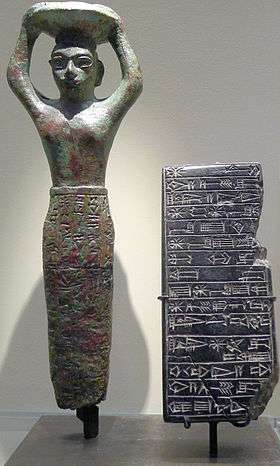Amar-Sin

Amar-Sin (initially misread as Bur-Sin) (ca. 1981–1973 BCE short chronology) was the third ruler of the Ur III Dynasty. He succeeded his father Shulgi (ca. 2029–1982 BCE).[1]His name translates to 'immortal moon-god'.
Year-names are known for all 9 years of his reign. These record campaigns conducted against Urbilum, and several other regions with obscure names: Shashrum, Shurudhum, Bitum-Rabium, Jabru, and Huhnuri.[2] Amar-Sin is otherwise known to have campaigned against Elamite rulers such as Arwilukpi of Marhashi, and the Ur Empire under his reign extended as far as the northern provinces of Lullubi and Hamazi, with their own governors. He also suppressed a rebellion in Assur where he appointed an Akkadian governor, Zariqum as confirmed by his monumental inscription.[3]
Amar-Sin's reign is notable for his attempt at regenerating the ancient sites of Sumer. He apparently worked on the unfinished ziggurat at Eridu.[4] Eridu was abandoned during his reign. Salinity problems had made agricultural pursuits in this region unprofitable.
The Babylonian Weidner Chronicle records the following: "Amar-Sin... changed the offerings of large oxen and sheep of the Akitu festival in Esagila. It was foretold that he would die from goring by an ox, but he died from the [scorpion?] 'bite' of his shoe."
References
- ↑ John Bagnell Bury; et al. (1925). The Cambridge Ancient History. Cambridge University Press. p. 607. ISBN 0-521-07791-5.
- ↑ Year-names for Amar-Sin
- ↑ Zariqum does not appear on the Assyrian King List tablets, but is usually placed by archaeologists between Akkiya and Puzur-Ashur I. He is well known from contemporary documents as a career governor who was also appointed over Susa at various times between Shulgi year 40 and Shu-Sin year 4. See Potts, The Archaeology of Elam, p. 132.
- ↑ Mallowan, Max, "The Development of Cities from Al-U'baid to the end of Uruk 5" (Cambridge Ancient History)